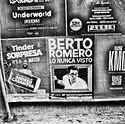Hello All,
Long time lurker, occasional poster here.
I have recently revised and re-designed a booklet that I wrote a while back aimed at helping anyone familiar with hand coating cotton papers achieve an even coating of platinum and palladium (and other alt technique) solutions on fixed-out baryta paper.
If you have some extra or out-of-date baryta aka fibre-based photo paper laying around, you can fix the silver out of it, wash it and dry it and have a fantastic substrate for alt process printing....if you can convince the solutions to cooperate. It took me a couple of years to figure out just how to do that, but I finally managed it and that is what my "how to" guide is all about.
Plat/palladium prints on baryta paper have the same subtle gradation of tones as prints on cotton paper but, according to my most recent measurements, they have nearly a gajillion times more detail and a boat-load more Dmax. The warm tones are more intense, the depth more, well, deeper, and the images are so sharp that you may want to have a first aid kit handy in case you cut your eyeball looking at them.
WARNING SELF PROMO ALERT:
So I am posting here today to let you all know that my guide is now available (in a new and improved design) via Blurb just in time for Festivus. If you would like to purchase a copy, hit the "buy" button here, and feel good knowing that you will soon be making platinum/palladium prints that make all others look like anemic vampires and that I have promised Sean that I will donate a percentage of the sales to APUG.
Here's the blurb link: http://www.blurb.com/my/book/detail/1819950
Happy printing!!!
Long time lurker, occasional poster here.
I have recently revised and re-designed a booklet that I wrote a while back aimed at helping anyone familiar with hand coating cotton papers achieve an even coating of platinum and palladium (and other alt technique) solutions on fixed-out baryta paper.
If you have some extra or out-of-date baryta aka fibre-based photo paper laying around, you can fix the silver out of it, wash it and dry it and have a fantastic substrate for alt process printing....if you can convince the solutions to cooperate. It took me a couple of years to figure out just how to do that, but I finally managed it and that is what my "how to" guide is all about.
Plat/palladium prints on baryta paper have the same subtle gradation of tones as prints on cotton paper but, according to my most recent measurements, they have nearly a gajillion times more detail and a boat-load more Dmax. The warm tones are more intense, the depth more, well, deeper, and the images are so sharp that you may want to have a first aid kit handy in case you cut your eyeball looking at them.
WARNING SELF PROMO ALERT:
So I am posting here today to let you all know that my guide is now available (in a new and improved design) via Blurb just in time for Festivus. If you would like to purchase a copy, hit the "buy" button here, and feel good knowing that you will soon be making platinum/palladium prints that make all others look like anemic vampires and that I have promised Sean that I will donate a percentage of the sales to APUG.
Here's the blurb link: http://www.blurb.com/my/book/detail/1819950
Happy printing!!!














